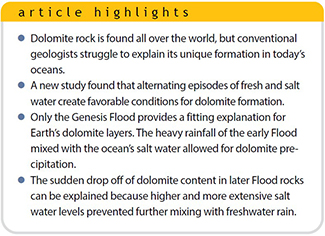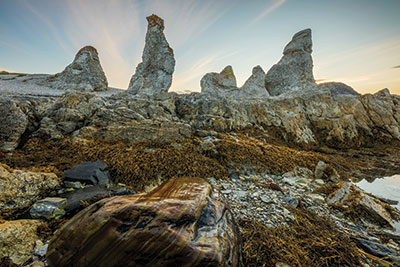 Dolomite is a very common sedimentary rock, comprising about 30% of all carbonate rocks.1,2 Its chemical formula is MgCa(CO3)2, whereas the more common limestone is CaCO3. Oddly, ocean water is supersaturated with respect to dolomite, yet it doesn’t readily form from typical seawater. After more than 200 years of study, very little is known about how dolomite forms. In the modern world, it has only been found in tiny amounts in a couple locations and under very unusual conditions.3
Dolomite is a very common sedimentary rock, comprising about 30% of all carbonate rocks.1,2 Its chemical formula is MgCa(CO3)2, whereas the more common limestone is CaCO3. Oddly, ocean water is supersaturated with respect to dolomite, yet it doesn’t readily form from typical seawater. After more than 200 years of study, very little is known about how dolomite forms. In the modern world, it has only been found in tiny amounts in a couple locations and under very unusual conditions.3
This mystery is further complicated by the fact that dolomite and dolomite-rich rocks are more common in the oldest sedimentary layers and significantly less common in later strata. As one study concluded:
This lack of knowledge has been termed the dolomite problem, which can be expressed as follows: at present, large quantities of dolomite do not seem to form in nature under the geochemical conditions of the past sedimentary cycles.4
Studies have shown that the dolomite-to-calcite ratio is highest at 3:1 in pre-Sauk Megasequence rocks (pre- and earliest Flood). It decreases dramatically to 1:80 in late Zuni Megasequence rocks (highest point of Flood), and there’s essentially zero dolomite found in post-Flood rocks (Ice Age and modern).5

Over the years, geologists have proposed numerous models to explain the formation of dolomite.6 But none can adequately account for the thick, continuous deposits observed in the early Flood rocks.
A recent study has shed new light on this topic.1 The collaborating scientists found that magnesium and calcite can randomly attach on the surface of a growing dolomite crystal. However, this creates a partially disordered surface that hinders further crystal growth, stopping further deposition of dolomite.
Their breakthrough discovery was that the disordered regions are more easily dissolved than the ordered regions. They concluded, “If the solution is instead cycled between supersaturation and undersaturation [fresher water], then both dissolution and reprecipitation processes can be activated iteratively.”1 They added, “Excess freshwater [rainwater] would lead to dolomite undersaturation, dissolving the more-soluble, disordered surface regions.”1 In other words, fresher water dissolves away the disordered atoms, allowing more dolomite production.
Repetitive cycles of fresh water alternating with ocean water seem to be the key. Lots of rainfall is the secret ingredient. This may not fully resolve the dolomite problem, but it’s a start.
What would create a condition where fresh water was frequently cycling with seawater on a global scale? The Flood described in Genesis. Recall the initial 40-day period of heavy rainfall and the repetitive, tsunami-like waves crashing across the continents from plate movement.7 This would have created better conditions for fresh and ocean water fluctuations, providing the chemistry needed to make dolomite.
As the floodwater rose higher, there would have been less mixing with fresh water as the oceans covered more land, preventing dolomite production. By the time the Zuni Megasequence (high-water point) was deposited,7 there would have been very little mixing since the ocean water entirely covered the earth. This could explain the dramatic drop-off of dolomite production in later Flood rocks. Today there remains little opportunity to create the chemistry fluctuations needed to produce dolomite.
Evolutionary scientists may still be baffled, but Genesis provides the best answer for the dolomite problem.
References
- Kim, J. et al. 2023. Dissolution enables dolomite crystal growth near ambient conditions. Science. 382 (6673): 915–920. DOI: 10.1126/science.adi3690.
- Carbonate rocks total about 23% of the world’s sedimentary rocks. This value is from unpublished ICR research across five of the world’s continents.
- Leeder, M. R. 1982. Sedimentology: Process and Product. London, UK: Unwin Hyman, 297.
- Pina, C. M. et al. 2020. Dolomite cation order in the geological record. Chemical Geology. 547 (119667). Emphasis in original. DOI: 10.1016/j.chemgeo.2020.119776.
- Blatt, H. et al. 1980. Origin of Sedimentary Rocks, 2nd ed. Englewood Cliffs, NJ: Prentice-Hall, Inc., 512.
- Davies, G. R. et al. 2006. Structurally controlled hydrothermal dolomite reservoir facies: An overview. AAPG Bulletin. 90 (11): 1641–1690.
- Clarey, T. 2020. Carved in Stone: Geological Evidence of the Worldwide Flood. Institute for Creation Research: Dallas, TX.
* Dr. Clarey is Director of Research at the Institute for Creation Research and earned his Ph.D. in geology from Western Michigan University.













